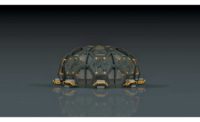Gardner Builders, a Minneapolis-based contractor, turned over on July 23 what is believed to be a first twofer in the industry: a finished project along with a digital twin of the project documentation, secured and unchangeable—or “immutable,” in blockchain parlance—because it exists on multiple databases that are all kept in sync. That is a hallmark of the blockchain technology. Any attempt to modify a record stored in the blockchain will violate the synchronization protocol and be revealed and prevented.
“We are early adopters,” says CEO Bob Gardner. “This is the first project that’s ever been done this way. This was a test drive.”
The project was the renovation and fitting-out of a space for an exercise center called Discover Strength in Minneapolis, part of an expanding chain in Minnesota. The digital twin was created using the services of Brickschain, a company launched in January. Cofounder and CEO Bassem Hamdy was previously an executive at Procore for three years, and prior to that was at CMiC for 16 years.
“Bob is technology forward,” says Hamdy. “He was awesome in getting involved with us." He said Gardner, whom he knew from Procore, and who has been following the development of Brickschain, had approached him a month earlier. Gardner wanted to use Brickschain to capture and secure all of a project’s documentation in a blockchain ledger with a system that could be navigated and turned over to the owner as a deliverable at handover.
“People keep saying construction is slow about adopting new technology, but construction can move fast. It’s just a matter of finding the right project and contractor,” Hamdy says. “This is historic in a lot of ways, and now we have real data only 30 days later.”
Collecting project data took a week, Hamdy says. “Brickschain nodes” were installed on the project’s Dropbox and Procore accounts. The system automatically scraped IFC data about objects contained in the electronic files of the project’s 2D plans. It also captured all submittal transactions using software APIs.
In this case, where the system was implemented just prior to handover, neither the architect, contractor, subcontractors, nor the suppliers had to actively collect asset data. Brickschain harvested it all by scraping the records that had coursed through the Dropbox and Procore accounts. In a project set up at an early stage, all stakeholders potentially could install nodes and capture all transactions of data going into creation of a project from their own servers as they occurred, time-stamped and secured in the distributed blockchain ledger.
“Traditional discovery will be obsolete,” claims Hamdy. David Bowcott, global director for growth innovation and insight with Aon Risk Solution’s Global Construction and Infrastructure Group, agrees. “The Brickschain has the potential of making dispute resolution very quick [as in], you're the guy that changed it last and this shows me you are responsible.”
“Definitely there is a significant interest in the owner and lender community of everything that went on during the asset’s creation. From the insurance position we’re pretty interested. And if you are an owner you have the knowledge; any time they create an entry related to that project it gets captured,” Bowcott says, adding, “The market is moving toward a more transparent model, and the owners can mandate it. What are you going to do? And my understanding is, it’s actually pretty easy.”
The results are presented in a Brickschain interface that looks like a typical Microsoft Windows file-structure display. The blockchain ledger of the collected data, or “transactions,” is navigated by clicking on files representing rooms.
Inside each room are links to the records stored in the blockchain that define every installed asset. Specifications of the products are granular, down to paint colors, ceiling fixtures, LED bulbs, door hardware, along with the manuals and warranty information and service life in a countdown clock. All are harvested from the manufacturers as part of Brickschain’s asset inventory creation process. If the manufacturer updates a manual or issues a recall, that also will be captured in the future as a new “transaction” associated with that asset, with the change flagged to the owner, should the owner choose to maintain the active Brickschain subscription.
“We built a file system. It’s just like a file explorer,” says Hamdy.
“Normally, when preparing documentation for closeout, it can take us a month to collect all of that information,” says Gardner. “It’s a highly manual process and it’s the bane of many owners' existence, and when they need the data because something goes wrong, it's not there. Brickschain captured all of our documents along with a data sweep of the entire project, and there is no chance they can get it wrong because the data is secured—and it’s not the data from three versions previous.”
Luke Carlson, CEO of Discover Strength, says he went through the orientation after handover and found the Brickschain system intuitive and comprehensive. “We do expect to use this data as we plan the build-out and launch of our next location. I envision the data and software as a key component in maintaining both consistency and efficiency while scaling our business,” Carlson says.
“I’m excited about having our operations people be able to make decisions locally, rather than centrally, as all relevant data will be at their fingertips. Ultimately, I foresee us achieving speed, consistency, and efficiency,” Carlson says.
“Hopefully the owner will put their portfolio on it and maintain it,” says Hamdy. “We charge basically the same for a building to be put on the blockchain as we will for the annual maintenance long-term, or you can host your own node. Your data can be on your own servers. Or we can give you your own blockchain on Amazon Web Services.”
Although the startup is just getting going and still working its pricing out, Hamdy says the cost for creating or maintaining a digital twin with Brickschain will be around 10¢ per sq ft.





Post a comment to this article
Report Abusive Comment